Stables development
Early stables provision is shown in the historic plans of Camden Goods Depot. The third phase of development of the Goods Depot in 1854-6 saw the goods yard extended north to Chalk Farm Road, requiring demolition of the 1844-6 ranges and building of four new stables in their present locations, in the triangle between Chalk Farm Road and the NLR viaduct. A new access route was provided from the stables area to the goods yard by means of a tunnel, the Eastern Horse Tunnel.
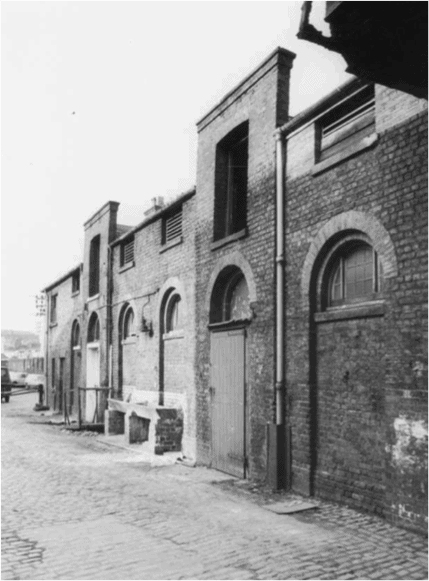
The four 1856 stable blocks were built as plain yellow stock brick ranges of single storey stables with hay lofts, as seen in the western bays of The Stables (Malcolm Tucker, 1975). They are estimated to have stabled 162 horses. Wooden stairs (none of which remain) provided access to the pitching holes of the hay lofts. Windows with high sills and round-headed openings to the ground floor provide light and ventilation to the stalls from above. Typically stall dividers were of the hanging type (“swing bales”). However, little remains of the former stable fittings.
New stables were also constructed by LNWR in this phase on the south-west side of Gloucester Road on the site of a former brewery owned by Calverts. This site lies behind The Engineer public house (also built c1856), which was retained by Calverts. There was stabling for an estimated 140-150 horses. The stables were connected to the goods yard by the Western Horse Tunnel. They were rented by Pickfords following the 1857 fire in the Oval Road warehouse that they had rented from LNWR (which destroyed the basement and its stables for some 250 horses).
LNWR built stables for Samuel Allsopp and Sons, the Burton-on-Trent brewers, in 1876 on the north side of Gloucester Road, the site now of 42 Gloucester Avenue. They were connected by horse stairs to the Western Horse Tunnel. The stables are estimated to have held 72 horses. The new stables provided access to the storage area Allsopp leased in the basement of the main goods shed. They were demolished in Spring 2000, but the horse stairs and tunnel remain.
The growth of Gilbeys from its arrival in 1869 substantially increased the need for horses. Further, the construction of Gilbey’s No. 2 Bond in the 1880s displaced horses stabled in the vaults behind, which became part of the bonded store. This probably explains the 1881/1883 phase of stable building. In 1881 floors were added to all 1854-6 stables except The Stables, with fodder stores, tack room, and a stable for 26 horses reached by ramps. In 1883 a new two storey range, now commonly known as the ‘Horse Hospital’ was built west of the four stables in Stables Yard. It accommodated 92 horses on two floors, including 12 loose boxes for sick or injured horses. This range was extended to the southeast in 1897, providing stabling for an additional 40 horses.

An upper floor with a gallery for access (see photo above) was added to The Stables along Chalk Farm Road in 1900. This provided stabling for 42 horses.

Two stables for 17 horses were provided at some time beneath the NLR viaduct and four stalls in 1887 in a lean-to stable. A further 54 horses could be stabled by the 1920s beneath the former coal drops. The total stabling in Stables Yard in 1925 was for about 400 horses.
In 1893 part of Gilbey’s No. 5 Bond, housed under the arches of the NLR at Camden Road station, was converted into stables by the NLR. The stables, which open onto Bonny Street, could accommodate 104 horses. It is assumed these horses worked in the Goods Depot where Gilbeys had its main operation and would previously have been housed there in stables rented from the LNWR.
At the peak, therefore, some 700-800 horses worked in Camden Goods Depot moving goods to and from the yard and shunting railway wagons. For passenger operations, the LNWR had additional stables at Euston and Broad Street. Carriage of parcels and luggage to and from the station had been placed in the hands of Pickfords and other carriage agents, and these agents would have stabled the many horses required for these services.
There is an interesting seven-minute Pathe News clip showing life in the Camden stables of the LLMSR in 1949. The title of the clip is Flu Epidemic Among Railway Horses, but as well as treatment by a vet, it shows feeding, shoeing, leading to work, stalls, and harnesses. It can be viewed at:
www.britishpathe.com/record.php?id=56505
The Stables
The Stables was built in 1856 as a 1½ storey range 28 bays long in plain yellow stock bricks with a slate roof. It follows the line of Chalk Farm Road, onto which it backs. The eastern 21 bays, which step back slightly to the south, were raised in 1900 to provide an upper storey of stabling.
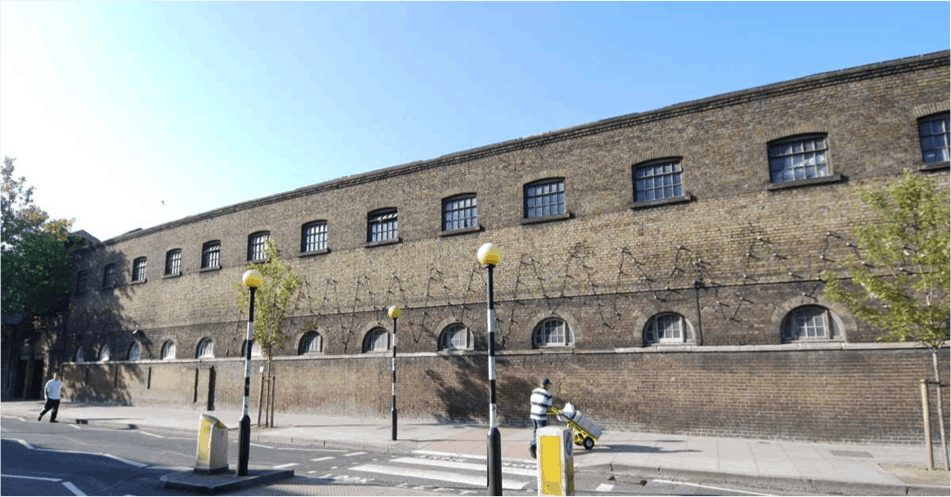
The western seven bays of The Stables are the only surviving part of the four 1856 ranges to retain the original single storey and loft arrangement. This section has two stabling units of three bays with flat-headed central projecting entrance and loophole or loft opening bays.
At the west end, a two-storey bay under a hip in the roof with a chimney stack has every appearance of a gatehouse. Its stair is to the south-east. The south-west corner of the building has its corner cut at 45º, evidently to provide better turning space for horses and wagons.

Further east the ground floor is in seven three-bay units, with the addition of piers to support a cantilevered steel and brick jack-arch gallery with concrete floor, by which the upper stables were reached. Access to the gallery was via a ramp attached to the north side of Long Stable. The floor to the upper storey is of steel and brick jack-arch construction contiguous with that of the gallery. A wooden bridge that formerly connected The Stables and Provender Stores was removed. The upper stables repeat the three-bay pattern but with segmental-headed doors and windows and dentilled eaves. The gallery retains its precast concrete drinking troughs.
Along Chalk Farm Road, the ground floor façade has high-level semi-round windows sitting on a continuous stone band. Some retain timber small-pane casements. On the raised section, where the windows are segmental-headed, a change in the brickwork is evident.
Internally, the stable units were each about 19 ft (5.8 m) by 28 ft (8.5 m) with three stalls on each side of a central passage. The original west section retains timber internal construction with the 1856 hay loft roof. The former gatehouse has been much altered internally.
Provender Stores

The Provender Stores backs onto the curved line of the NLR, though narrowly separated from it. An 18-bay range in plain yellow stock brick built in 1856 as single storey stabling with hay lofts, it was raised in 1881 by two storeys to provide provender storage, as shown in the drawing (National Archives).
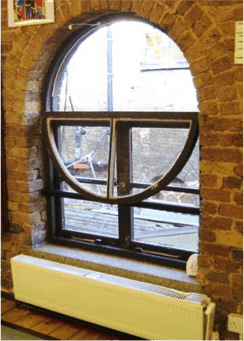
The ground floor stabling is typical, the bays being grouped in threes with central entrances, upper loophole openings, and round-arch arcading with high-silled windows for small pane pivoting casements. The first floor has round-headed windows, the second floor segmental heads. Many of the loophole openings, which were extended to both upper storeys, have been enlarged. All but one of the timber hoist jibs at eaves level have either been removed or replaced by steel beams.
The east gable end wall has been rebuilt in blue brick. The west gable end has a bridge to the Tack Room at first floor level recreated in 2015 to match the original, which had been removed.
Internally the range comprised six stable units, some with six stalls, others with loose boxes. The floors inserted in 1881 were of iron construction with trussed beams. Timber roof trusses were used. The upper floor and roof appear to have been replaced in concrete and steel.
Long Stable
Built in 1856 as a building seven bays long, Long Stable was raised in 1881 to provide an upper level of stabling for a further 24 horses reached by a ramp on the south side, as shown in the drawing (National Archives).
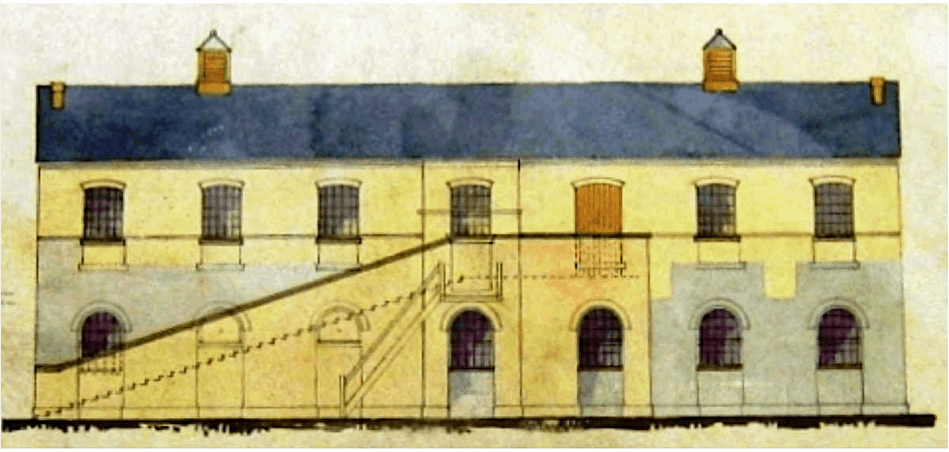
On the ground floor, as elsewhere, round-headed openings with high level sills light and ventilate the stalls from above. The later first floor openings have segmental heads. The east gable end has a small upper-storey hatch over a widened ground floor opening. The west gable end has had its upper-storey opening enlarged as a goods hatch.
The 1881 “horse road” to the south had steps with 4½ in. risers made of cast iron. Its position is evident on the south wall. The ramp to the north is brick built with concrete-paved road surfaces and an intermediate landing. A second ramp was added to the north in 1900 to provide access to the gallery on the upper storey of The Stables, as shown. Only this latter ramp now survives.

Although the shortest of the four 1856 stable blocks, the 28 stalls in a single undivided space explain the name of this block. The upper floor rests on cast-iron stanchions that support wrought-iron I-section girders carrying rolled joists to brick jack-arches and supports timber king-post roof trusses.
Tack Room
This range is generally assumed to have been built in 1856, although there is strong physical and documentary evidence that it may have been built earlier, not long after the 1847 reconstruction. It differs from other ranges at the eastern end with flat-headed windows and 12-paned sashes. It was raised in 1881 as part of the expansion of the Provender Stores, when the ranges were linked by a bridge, now removed. The west side is abutted by the railway vaults and the c1880 bonded warehouse.
The slate roof is in two parts: gabled to the south and hipped to the north. The three bays of the ground floor originally stabled 27 horses. The first floor provender store was later used as a tack room, hence the name.
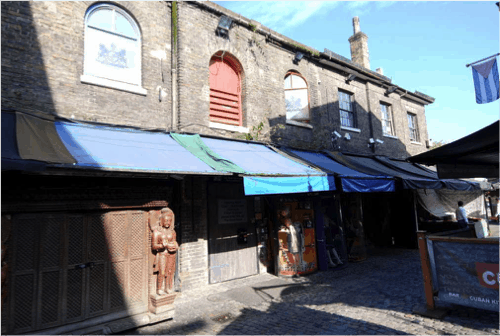
The east elevation has the same arrangement to the ground floor as the other 1856 stabling. Each of the three stables has three arched bays with a central projecting entrance bay and the flanking bays closed up to the round-headed windows, many of which still retain their original wooden frames. The northern loading bay retains a simple hoist over the head of the door.

Next to the northern stable is a door opening for access to the first floor horse-keeper’s dwelling, formed from the three northernmost bays. These were probably part of the original construction and retain three 12-pane sash windows and chimney stacks to both the east and north sides. Three brick chimney stacks remain to the north and east sides.
The bridge to the Provender Stores extended from the southernmost loading bay. Its position is indicated by a wooden rail and the holes for the former beams below the raised sill of the loading door. The bridge was demolished sometime after 1975 but a replacement recreating the original was erected during a refurbishment in 2015.
The interior of the building has three bays to both floors. It was originally built of timber-framed construction, still surviving to the northern stable bay. In 1881 the southern bays were altered and cast-iron columns and girders were inserted and the wooden floor was renewed. Wooden roof trusses and timber benching, partition and harness hooks survive from its later use as a tack room.
Horse Hospital
When this range of stables was first planned its narrow sloping site was already embanked on the north side for the inclined roadway that led to a coal yard and enclosed to the south by coal drops. The two-storey range was built in two phases: the western and larger part in 1883, the eastern part in 1897. The south elevation steps back, marking the building phases, whilst the north side has a continuous building line except for the later addition of a single-storey bay store and men’s room at the east end. At the west end is a small lean-to, formerly the boiler house, and a curved horse ramp

The first phase comprises the five western bays and accommodated 92 horses. The second phase includes three bays of two storey stabling and a single-storey office bay, providing additional stabling for around 40 horses and a store-room. All parts are built of yellow stock brick with red brick floor bands, dentilled cornices and segmental window heads, although with poorer quality detailing to the later range. The first phase has oculi to the end gables, although obscured to the east by the later building. The slate pitched roof on wooden roof trusses, gabled to the stable ranges and hipped to the former store-room, has a long louvred vent to the ridge of the earlier range and a small vent to the extension. In addition, the original stable range had five ventilation stacks to the north side of the roof but no evidence of these now survives externally.
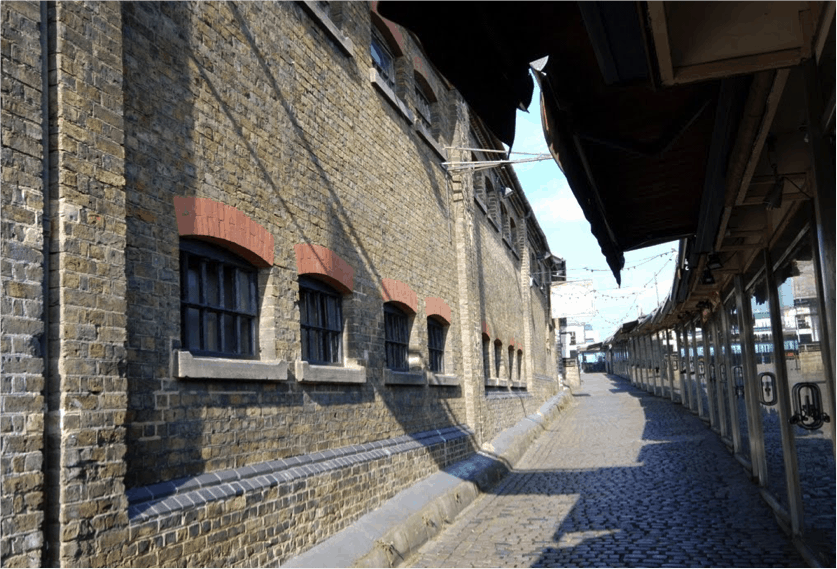
The north elevation abuts the horse road, an embanked roadway, its angle of incline reducing the 1883 range to a single storey on this side (image from 2007). The elevations of both parts have recessed panels, divided by pilaster strips, each with four high-level segmental-headed stable windows. In recent years two of the window openings have been extended to form doorways. The stable ranges are linked by another horse ramp, originally built against the east end of the first phase and retained after the extension was added, although partly remade into steps after the closure of the stables.
The southern elevation steps back three times. The upper elevation of the original part and both storeys of the extension are blank brickwork apart from the short segmental-headed stable windows. However, the ground floor of the 1883 range is quite different, all five bays having a pair of cast-iron, classically finished columns to central openings, flanked by large wooden-framed windows all under iron lintels. This open-fronted arrangement, not present elsewhere on the site, suggests that the ground floor was probably intended for cart sheds, the design later being changed to stables under pressures of growing horse numbers.
The upper storey of the west end has a landing for the semi-circular horse ramp with an opening to its balustrade, originally for a wooden chute to the manure pit below. The lower, straighter part was added as part of the 1897 extension. The curved ramp is uncommon, ramps usually being built against the side of a stables building for economy of space. Its shape and position were evidently dictated by the site. In the first phase it had a steep gradient of about 1 in 6 that was flattened when the ramp was extended in the second phase.

The eastern end of the 1897 range narrows to form a single-storey bay. This was a store and men’s room heated by a fireplace as indicated by the surviving chimney stack.
Ventilation to the north side of the stables was through the openings, two to each bay, at the junction of the wall and ceiling, with wooden shafts carrying up to vents on the roof. A single-storey store-room to the east, set back from the stable range but part of the original phase of construction, retains the brick jack arching of the former horse ramp above. The horse ramp at the western end also has a store-room below its upper part.
The interior of the 1883 building has cast-iron columns, classically finished, supporting brick jack-arching to the upper floor. The ground floor is divided by thick brick walls into five stable bays accessible only from the south side. There were six stalls to both sides of each room, making 60 stalls on the ground floor. Originally there were harness racks to the centre of each bay and corn bins against the north wall. The original brick-paved floor survives. It has a slight camber and is incised with gulleys for drainage.

The first floor of the 1983 range is divided into two unequal parts (National Archives). The larger western part retains twelve loose boxes with iron doorposts, cast as a piece with the columns that are bolted to tie-beams, and timber boarding below the iron grilles and rails. These loose boxes, with their columns and cast iron door posts, retain the most substantial surviving stable fittings in the stables complex, including mangers and hayracks and remains of the wooden ventilation shafts that originally ran from the floor to the roof (Proud Camden, 2008). Loose boxes were provided for resting tired or lame horses and led to this range of stabling becoming known as the “Horse Hospital”.

The eastern part of the range, designated as standings for 20 horses, was built with wooden bales suspended from joists between the roof beams. Some tethering hooks and a solitary trough are now the only surviving fittings.
The ground floor of the 1897 stable extension is in two parts and has a plainer construction, with I-section stanchions supporting the brick jack-arching. In the western part the stalls were against the north and south walls with dividers suspended from hooks in the ceiling beams, confirmed by the direction of the gulleys in the paved brick floor. Brackets beneath the tie beams on the first floor secured wooden posts to alternate stalls. The narrowest eastern part had stabling on the north side only. No stable fittings survive from the 1897 stable range.
Horse tunnels
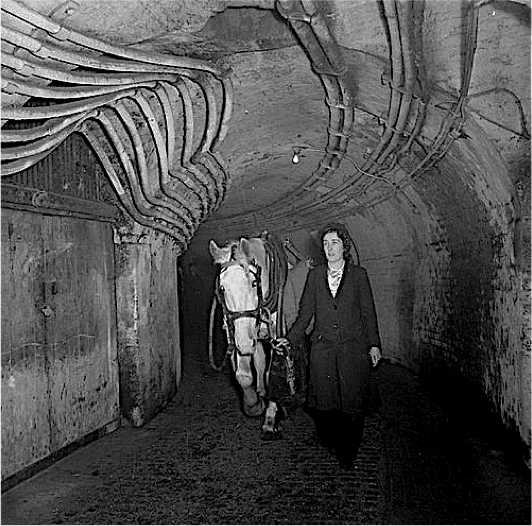
In 1854-56 the remodelling of the Goods Depot extended the land at railway level to its present boundaries. Two horse tunnels were provided under the railway embankment so that horses could move to and from their stables more safely beneath the tracks. These are referred to as the Eastern Horse Tunnel and the Western Horse Tunnel
The Eastern Horse Tunnel was connected both to the extensive system of vaults of 1856 west of the Interchange Warehouse formerly used for storing wine or beer and to the 1839 vaults, before emerging in Stables Yard. It followed a crooked course, starting with horse stairs that descended from the railway offices in Oval Road to circumnavigate the canal dock and the vaults (image courtesy of IWM), and passed under the rail lines leading to the dock.
The Western Horse Tunnel served to connect the new stables built by LNWR on the west side of Gloucester Road with the goods yard, emerging at the north-eastern end via horse stairs at a location that became the south-east corner of the goods shed when it was built 10 years later. The south-western end of the tunnel emerged as a ramp at the LNWR stables. In 1876 the LNWR built stables for Allsopps on the east side of Gloucester Road and connected these to the Western Horse Tunnel via horse stairs.

Both horse tunnels are of round-arched construction with asphalt over the top of the tunnel and damp-proofing cavities within the walls, draining to 4 in (10 cm) lateral drains and a 6 in (15 cm) longitudinal drain pipe below the centre of the tunnel – a quite sophisticated construction. The tunnels of brick construction with concrete footings are 10 ft (3.0 m) wide by 9 ft (2.7 m) to the crown, formerly with random Rowley Rag paving 6 in (15 cm) thick on 6 in (15 cm) of hardcore (Network Rail).

Cast-iron ventilation grilles were placed regularly (about 10 ft or 3.0 m apart) in the roof, originally the only source of light (Howard Spencer, 2008)
Sometime between 1856 and 1866, when many of the vaults were used by Bass and Allsopps for storing beer and ale, a branch tunnel was made from the Eastern Horse Tunnel to the 1839 vaults. This may have been used for trundling barrels by barrow or trolley as the passages were too narrow for use by horse-drawn vehicles.
In 1866, following the construction of the large goods shed in 1864, a branch was made from the Eastern Horse Tunnel to the basement of the shed.
The stairs of the Western Horse Tunnel, which now emerged at the south-east corner of this goods shed, were relocated southwards when the main goods shed was enlarged in 1931.
